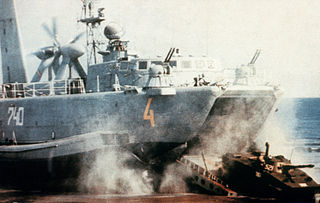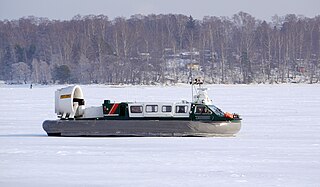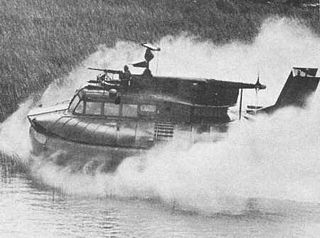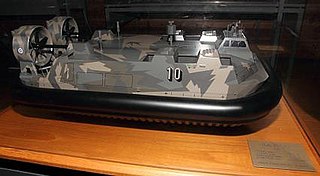 W
WAn air-cushioned landing craft, also called an LCAC, is a modern variation on the amphibious landing boat. The majority of these craft are small- to mid-sized multi-purpose hovercraft, also known as "over the beach" ("OTB") craft. This allows troops and material to access more than 70 percent of the world's coastline, while only approximately 15 percent of that coastline is available to conventional boat-type landing craft. Typical barriers to conventional landing craft are soft sandy beaches, marshes, swampland, and loose surfaces. Air cushion technology has vastly increased the landing capability of the craft, providing greater speed and flexibility over traditional landing craft.
 W
WThe Aist class was the first large assault hovercraft operated by the Soviet Navy. It was designed by the Almaz design bureau wing of the Almaz Shipbuilding Company in 1964–1965. Production of the craft lasted from 1970 until 1985 at Almaz's plant in Leningrad.
 W
WThe British Hovercraft Corporation BH.7 was a medium size hovercraft. It was the first quantity-production hovercraft to be specifically developed for military applications.
 W
WThe Griffon 2000 series is a light-weight hovercraft built in the United Kingdom by Griffon Hoverwork and used principally by military and rescue organisations.
 W
WHovercraft tank, or, officially, the amphibious hovering tank was developed at Moscow aircraft plant #84 in the USSR in 1937 by a group of engineers led by professor Vladimir Israilevich Levkov. Its development never left the mockup stage.
 W
WThe Type 722 II class LCAC with NATO reporting name Jinsha II class LCAC is a medium size air-cushioned landing craft (hovercraft) operated by the People's Liberation Army Navy of China. It is frequently but erroneously referred by many as Dagu class, its predecessor, due to misspelling and lack of information in the 1970s, when these projects first appeared. There are also other names for this class, mostly resulting from different transliterations.
 W
WThe LACV-30 was a hovercraft used by the U.S. Army Mobility Equipment Research and Development Command (MERADCOM) for offloading cargo from amphibious ships. For logistic transport, the Army was already using the LARC-V and LARC-LX, huge 4-wheeled vehicles referred to as 'barges on wheels'. The Army used the LACV-30 to transport 20 ft. standard MILVAN containers as well as outsize loads that would not fit on a LARC-V or LARC-LX. MERADCOM operated 24 LACV-30s between 1983 and 1994.
 W
WThe Landing Craft Air Cushion (LCAC) is a class of air-cushion vehicle (hovercraft) used as landing craft by the United States Navy's Assault Craft Units and the Japan Maritime Self-Defense Force (JMSDF). They transport weapons systems, equipment, cargo and personnel of the assault elements of the Marine Air/Ground Task Force both from ship to shore and across the beach. It is to be replaced by the SSC.
 W
WThe Kalmar class are a class of medium-sized assault hovercraft designed for the Soviet Navy. The few remaining craft are operated by the Russian Navy.
 W
WThe Patrol Air Cushion Vehicle (PACV), also known as the Air Cushion Vehicle (ACV) in Army and Coast Guard service, was a United States Navy and Army hovercraft used as a patrol boat in marshy and riverine areas during the Vietnam War between 1966 and 1970. Six hovercraft were built, three for the Army and three for the Navy.
 W
WThe Slingsby SAH 2200 hovercraft is a small military hovercraft produced by Slingsby Amphibious Hovercraft Company of Kirkbymoorside, England, and used by the Finnish Border Guard.
 W
WThe Ship-to-Shore Connector (SSC), also known as the LCAC 100 class, is a system proposed by the United States Navy as a replacement for the Landing Craft Air Cushion (LCAC). It will offer an increased capacity to cope with the growing weight of equipment used by the United States Army and Marine Corps. As of 2015, the program is forecast to cost a total of US$4.054B for 73 hovercraft.
 W
WThe Solgae-class LCAC, often called Solgae 631 class because of the name of lead ship, is an air-cushioned landing craft (LCAC) designed for the Republic of Korea Navy, by Hanjin Heavy Industries, to operate from ROKS Dokdo and future Dokdo-class amphibious assault ships. This project during development that known as the LSF-II or Landing Ship Fast - II. The craft can carry a maximum load of 55 tons, land on hostile beaches doing 40 knots and it can climb at up to 6 degrees. They have 20 mm cannons for self defense. The crew cockpit carry three crew and a landing-force commander. The LCAC can also carry, in addition to troops, a main battle tank or two amphibious assault vehicles. So far three of these units have been delivered, and more are likely to be ordered. It has been offered for export to foreign navies.
 W
WThe Saunders-Roe SR.N5 was a medium-sized hovercraft which first flew in 1964. It has the distinction of being the first production-built hovercraft in the world.
 W
WThe Tsaplya class LCAC is a medium size assault hovercraft operated by the Russian Navy.
 W
WTuuli was a hovercraft built for the Finnish Navy. Originally intended to be the lead vessel of a class of four combat hovercraft, she was never officially commissioned and after having been laid up for the most of her career, she was broken up in 2013.
 W
WThe Zubr class is a class of Soviet-designed air-cushioned landing craft (LCAC). This class of military hovercraft is, as of 2012, the world's largest, with a standard full load displacement of 555 tons. The hovercraft was designed to sealift amphibious assault units from equipped/non-equipped vessels to non-equipped shores, as well as to transport and plant naval mines.